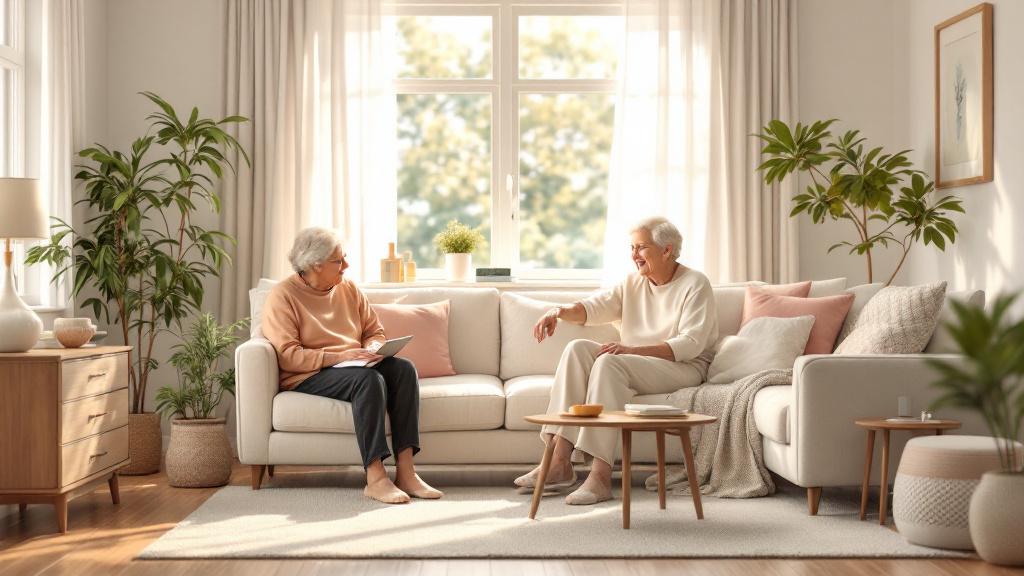How In-Home Care Services Encourage Seniors to Stay Active
Promoting Active Aging in Comfortable Settings

Understanding the Role of In-Home Care in Senior Wellness
As the aging population grows, maintaining an active lifestyle becomes essential for seniors’ overall health and happiness. In-home care services play a vital role in fostering physical, mental, and social well-being, helping older adults stay active, independent, and engaged within the comfort of their own homes. By offering personalized assistance and supportive activities, these services serve as a foundation for healthy aging and improved quality of life.
The Spectrum of Home-Based Support and Safety Modifications

What are the benefits of in-home care for seniors’ physical, mental, and social well-being?
In-home care offers numerous advantages that positively impact seniors’ overall health and happiness. By providing personalized assistance with daily activities, such as bathing, dressing, and mobility, caregivers help maintain physical health and reduce the risk of injuries or falls. Home safety modifications, like installing grab bars or improving lighting, further enhance safety and independence.
Socially, in-home care fosters companionship, encouraging seniors to participate in walks, hobbies, social gatherings, and community events. These interactions help combat loneliness and depression, supporting mental health and emotional resilience. Caregivers also offer emotional support, helping seniors manage feelings of anxiety or sadness.
Altogether, in-home care enhances the quality of life by enabling seniors to remain in familiar environments, stay active, and feel supported. This holistic approach ensures their physical, mental, and social needs are met, promoting healthier, happier aging in place.
Promoting Physical Activity through Personalized In-Home Care Strategies

How can in-home care services promote physical activity among seniors?
In-home care services play a vital role in encouraging seniors to stay active, which is essential for maintaining mobility, strength, and mental health. One effective approach is designing personalized exercise routines based on each senior's health status, preferences, and mobility levels. These routines often include gentle activities like walking around the house or garden, light resistance exercises using household objects, stretching, and balance-focused movements such as yoga or Tai Chi.
Care providers also support incorporating movement into daily tasks. For example, they might encourage seniors to perform simple household chores like sweeping or organizing, which adds to their physical activity without feeling like formal exercise.
Social and recreational activities are another component. Playing music for dance, joining group exercise classes at community centers, or even engaging in virtual fitness sessions can boost motivation and combat loneliness.
Utilizing household items as weights, such as canned goods or small bottles, provides accessible and affordable options for resistance training. Collaborating with physical therapists ensures activities are safe and suitable, reducing the risk of falls.
By integrating these strategies, in-home care services help seniors maintain an active lifestyle, thereby supporting overall health and promoting independence.
Encouraging Engagement and Exercise through Targeted Strategies

What strategies are used by in-home care to encourage senior engagement and exercise?
In-home care providers employ several approaches to motivate seniors to stay active and engaged. One effective method is integrating a variety of physical activities such as aerobic exercises, strength training, and balance routines into daily schedules. These are tailored to match each individual’s health status and abilities, ensuring safety and effectiveness.
Setting achievable goals and tracking progress is another crucial strategy. Caregivers help seniors set small, realistic milestones, celebrating improvements along the way to build confidence and motivation. Using simple record-keeping or technology-based logs helps both seniors and their families see progress, encouraging continued effort.
Social aspects play a significant role in making physical activity enjoyable. Caregivers often facilitate group sessions, walking groups, or buddy systems, fostering social interaction that adds fun and accountability. Incorporating community resources like senior fitness classes or hobby groups enhances the social engagement component.
Additionally, programs such as Tai Chi, yoga, resistance exercises, and other activity-based interventions are delivered at home, focusing on mobility, flexibility, and strength. These routines not only improve physical health but also contribute to emotional well-being through social connection and a sense of community.
Overall, personalized exercise plans, goal setting, social involvement, and safe, enjoyable activities form a comprehensive approach that motivates seniors to maintain an active lifestyle, helping them stay healthy, independent, and connected.
The Critical Role of Caregivers and Personalized Care Plans

How do caregivers and personalized care plans support active senior lifestyles?
Caregivers and tailored care plans are essential in helping seniors stay active and engaged. They adapt activities and support strategies to suit each senior's unique health conditions, preferences, and cultural backgrounds.
A personalized approach encourages independence and dignity by providing specific assistance with daily activities such as dressing, bathing, and meal preparation. It also promotes social connection through community involvement and cognitive stimulation activities like puzzles and reading.
In addition, caregivers use adaptive tools and technology, including wearable health monitors and virtual communication devices, to improve safety and help seniors stay connected. Regular assessments involving seniors, families, and healthcare professionals ensure that care evolves with changing needs.
These personalized plans foster a positive environment where seniors feel supported, motivated, and empowered to maintain an active, fulfilling life.
How does collaboration with healthcare professionals enhance these efforts?
Working closely with healthcare providers allows caregivers to fine-tune activities and interventions, ensure safe exercise routines, and manage health conditions effectively. This teamwork helps prevent injuries and maintain optimal health.
What role does technology and adaptive tools play?
Smart devices and adaptive equipment enable seniors to participate safely in physical activities and social interactions. These tools make it easier for caregivers to monitor health, provide assistance, and communicate, creating a connected, supportive network that promotes active aging.
Incorporating Daily Routines, Exercise, and Social Activities within the Home
How can in-home care incorporate exercise, daily routines, and social activities to support seniors?
In-home care plays a vital role in promoting an active and engaging lifestyle for seniors. Caregivers often develop personalized exercise routines, such as chair yoga, walking, stretching, or light strength training, tailored to each individual’s health and mobility levels. These routines help enhance mobility, balance, and overall strength, reducing fall risks and managing chronic conditions.
Establishing consistent daily schedules creates stability and comfort. Regular meal times, medication reminders, household chores, and scheduled social interactions help seniors feel secure and maintain daily functioning. Such routines also foster emotional well-being by providing a sense of purpose and normalcy.
Encouraging social activities is essential for mental health. Caregivers can facilitate face-to-face interactions through visits with family and friends, participation in community events, or outings to senior centers. For in-home engagement, virtual platforms like video calls, online games, and courses enable seniors to connect with loved ones and remain socially active, especially when in-person meetings are limited.
Technology further expands social opportunities. Video conferencing tools, interactive apps, and online social communities help seniors stay connected, combat loneliness, and stimulate cognitive function. Intergenerational activities, such as sharing stories or hobbies with grandchildren via digital platforms, can also nurture relationships.
Overall, by integrating exercise, structured routines, and social activities—both virtual and in-person— in-home care supports seniors’ physical health, emotional vitality, and social engagement, fostering a thriving, independent life at home.
Supporting Independence and Active Aging in the Comfort of Home

How does in-home care support seniors in maintaining independence and active aging?
In-home care plays a vital role in helping older adults continue living independently while staying active and healthy. It provides personalized assistance with essential daily tasks such as bathing, dressing, grooming, and household chores. This support ensures safety and comfort within familiar surroundings, which is crucial for emotional well-being.
Beyond basic caregiving, in-home services promote physical and mental health. Caregivers assist with meal preparation, grocery shopping, and transportation to medical appointments and social activities. They also monitor medication routines and health status, reducing risks associated with medication errors or health neglect.
Home modifications and safety assessments are essential components of preserving independence. Simple adjustments like installing grab bars, fixing loose railings, and improving lighting help prevent falls and accidents. Financial aid may be available to support these upgrades, making homes safer without burdening seniors financially.
Community engagement remains a cornerstone of active aging. Community programs, local agencies, and government services offer seniors opportunities for social interaction, hobbies, and physical activity. Day programs and social clubs help combat loneliness, boost mood, and foster connections.
Social and cognitive stimulation are further encouraged through companionship, mental exercises, and participation in hobbies or volunteer work. These activities help maintain memory, improve problem-solving skills, and provide a sense of purpose.
Overall, in-home care supports older adults in maintaining their independence by ensuring they have the necessary help, a safe environment, and community connections. This holistic approach enhances their quality of life, allowing them to live safely, actively, and with dignity in their own homes.
| Support Area | Services Provided | Benefits | Additional Details |
|---|---|---|---|
| Daily Tasks | Personal care, household chores | Safety, Dignity | Assistance with bathing, dressing, cleaning |
| Safety & Home Modifications | Home safety assessments, modifications | Fall prevention | Grab bars, ramps, improved lighting |
| Community Engagement | Social programs, transportation, day centers | Reduce loneliness | Hobbies, volunteer opportunities |
| Health & Wellness | Medication management, health monitoring | Chronic disease control | Regular check-ups, screenings |
| Cognitive & Social Activities | Puzzles, hobbies, conversation | Memory, mood | Mental exercises, storytelling |
Supporting independence and active aging at home involves a combination of personalized care, home safety measures, and community participation. Together, these strategies foster a healthy, engaged, and autonomous lifestyle for seniors.
Overall Impact and Benefits of In-Home Care for Seniors
In-home care plays a vital role in enhancing the overall well-being of seniors by addressing their physical, mental, and emotional needs in a familiar environment. It helps improve health outcomes through assistance with daily activities like bathing, medication management, and mobility support, which can prevent falls and reduce hospital stays.
Motivation and active engagement are encouraged by caregivers through tailored exercise routines, mental stimulation activities, and social opportunities. These efforts foster a sense of purpose, boost confidence, and support cognitive health, helping seniors maintain their independence longer.
This form of care also significantly contributes to mental and emotional well-being. Regular social interaction with caregivers, participation in hobbies, and connection with family reduce feelings of loneliness, anxiety, and depression. Engaging activities such as puzzles, gardening, and community involvement provide emotional comfort and mental stimulation.
Altogether, in-home care creates a comprehensive support system that promotes healthier, more motivated, and satisfied aging. Seniors are empowered to stay active, connected, and comfortable in their own homes, leading to improved quality of life and positive long-term benefits for aging individuals.
Fostering a Supportive Environment for Active Aging
In-home care services are instrumental in guiding seniors towards maintaining an active and fulfilling lifestyle. By emphasizing personalized support, safety, social engagement, and consistent encouragement, these services help older adults retain independence, improve their health, and enjoy life in the comfort of their own homes. As aging in place becomes a preferred choice for many, investing in comprehensive in-home care that promotes physical activity and mental stimulation is essential for enhancing senior well-being and fostering a vibrant, supportive community.
References
- Aging in Place: Growing Older at Home
- How Professional Caregivers Can Keep Clients Active
- How Home Health Care Can Help Your Senior Stay Physically Active
- How In-Home Care Promotes Mental Wellness in Seniors
- How Home Care Providers Can Help Seniors Stay Active and ...
- How Does Home Care Aides Help Seniors Get Exercise? | Blogs
- How to Help Seniors Stay Active at Home with Geriatric Care Services

How to Plan for Long-Term Home Care Services

How Home Team Helps Families Make Informed Care Decisions

How Home Team's Caregivers Provide Peace of Mind for Families



